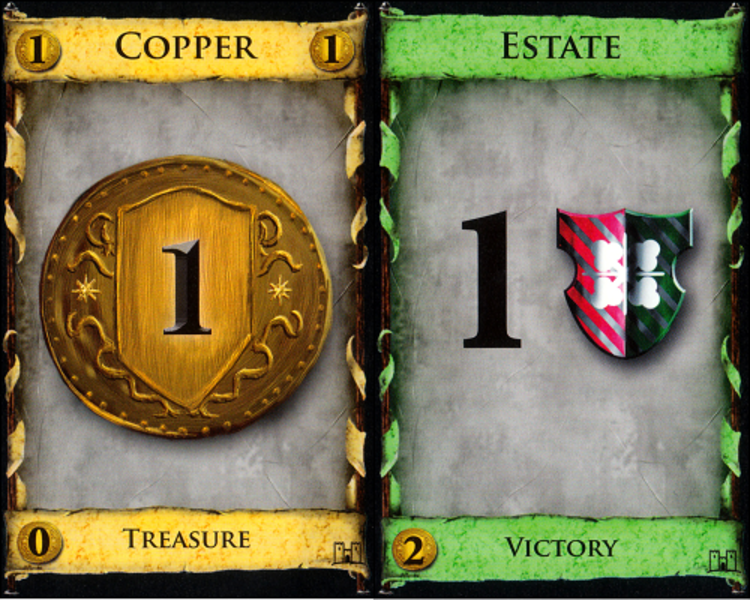Dominion starting hand
 In the game
Dominion
, each player begins with a shuffled deck of 10 cards, consisting of 7 Coppers and 3 Estates. In each turn, a player draws 5 cards, and at the end of the turn, a player discards all cards in play; thus, there is no card retained between turns. Copper and Estate don't allow the player to draw more cards, either, so a player's first two turns are always composed of drawing all the 10 starting cards in some order. For example, a player can draw 4 Coppers and 1 Estate in the first turn, then the remaining 3 Coppers and 2 Estates in the next turn.
In the game
Dominion
, each player begins with a shuffled deck of 10 cards, consisting of 7 Coppers and 3 Estates. In each turn, a player draws 5 cards, and at the end of the turn, a player discards all cards in play; thus, there is no card retained between turns. Copper and Estate don't allow the player to draw more cards, either, so a player's first two turns are always composed of drawing all the 10 starting cards in some order. For example, a player can draw 4 Coppers and 1 Estate in the first turn, then the remaining 3 Coppers and 2 Estates in the next turn.
An opening is the number of Coppers in hand for the first two turns. For the above example, the opening is called a 4/3 opening: 4 Coppers are drawn in the first turn, then 3 Coppers in the second. A 3/4 opening is functionally identical to 4/3, and likewise 2/5 is identical to 5/2. It can also be easily shown that there is no other kind of opening, so there are only two distinct openings: 5/2 or 4/3. Which opening is obtained depends wholly on the luck of the first shuffle.
If the probability of getting a 5/2 opening is where are positive integers that are relatively prime, determine the value of .
Assumption: Count both 5/2 and 2/5 opening, since they are identical as stated.
The answer is 7.
This section requires Javascript.
You are seeing this because something didn't load right. We suggest you, (a) try
refreshing the page, (b) enabling javascript if it is disabled on your browser and,
finally, (c)
loading the
non-javascript version of this page
. We're sorry about the hassle.
Instead of counting the Coppers, it's much easier to keep track of the Estates instead. A 5/2 opening can only happen if all three Estates fall into the same hand. (The hand containing the three Estates must necessarily contain two Coppers only, and the other hand has all Coppers, so that's a 5/2 opening.)
There are ( 3 1 0 ) = 1 2 0 possible ways on how the Estates are distributed in the deck. Among these, ( 3 5 ) = 1 0 ways will have all Estates in the first five cards (and thus will be drawn in the first turn), and ( 3 5 ) = 1 0 more ways will have all Estates in the last five cards (and thus will be drawn in the second turn). In total, there are 1 0 + 1 0 = 2 0 ways for the Estates to be in the same hand, so the probability of this occurring is 1 2 0 2 0 = 6 1 . This means a = 1 , b = 6 , and so a + b = 7 .